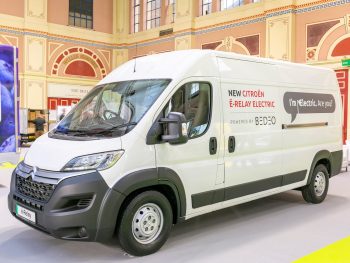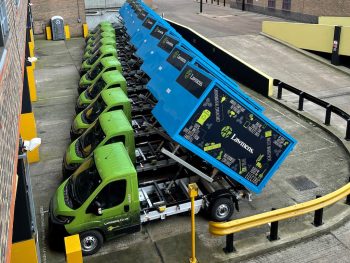BEDEO showcases electric van expertise at Freight in the City
LCV electrification specialist BEDEO has showcased three electric vans at this week’s Freight in the City event, highlighting the latest applications of its technology.

At Freight in the City, BEDEO displayed an electric Citroën ë-Relay van developed for Stellantis under the firms’ agreement
The firm, formerly known as BD Auto and Energy Ltd, manufactures and assembles its entire electrification range in-house, including powertrains, battery packs and electric vehicle conversion.
It’s recently expanded its platform to OEMs, where it acts as the electrification specialist for other brands – including for Stellantis, which has selected BEDEO as its exclusive partner to electrify its large LCV range for Vauxhall, Peugeot and Citroën brands in all European countries.
Vehicles displayed by BEDEO at Freight in the City, held at Alexandra Palace in London on 28 September, included a 100% electric refrigerated van used by Ocado to improve last-mile delivery.
Also on display was a 100% electric tipper operated by Lawmen; earlier this year, the London waste management firm deployed 10 of the vehicles, supporting its provision of zero-emission services in the London area.
The 4.5-tonne tippers are based on a Fiat e-Ducato chassis cab with bodies by Tipmaster and BEDEO’s inhouse electric drivetrain solution.
The tippers provide a payload of 1,125kg and a range of 160km (100 miles) in heavy-use working conditions. They can be fully charged overnight or a 60-100% charge can be reached in two hours via three-phase power.
The final vehicle displayed in the trio at Freight in the City was the electric Citroën ë-Relay model developed for Stellantis under the firms’ agreement.
All the vehicles displayed were 100% electric and powered by BEDEO’s proprietary technology.
Speaking at the show, Osman Boyner, BEDEO’s founder and CEO, commented: “For over a decade, BEDEO has been designing, engineering, building and manufacturing best-in class electric vehicle solutions, allowing our customers to meet their zero-emission goals. We’re proud to display these tangible examples of how BEDEO is contributing to the transition to zero-emission transport in metropolitan areas.”


